MARKETING AUTOMATION
Zapier vs Make (and why Shopstory is better)
27.06.2024

Zapier vs Make - Do you want to automate some of your marketing and/or ecommerce tasks, but feel stuck between two of the biggest players in the automation space? Before you decide, consider Shopstory – a powerful alternative built for ecommerce and marketers in mind.
We’ll break down Zapier, Make, and Shopstory, comparing their features, pricing, and functionality. If you're looking for ease of use, advanced customization, or a scalable solution, this guide will help you pick the best tool.
🚀 In the second half of this comparison, we’ll explore why Shopstory stands out with its user-friendly design, flexibility, and scalability. Stick around or jump right to the Zapier vs. Make vs. Shopstory section.
Short on time? Start automating with Shopstory for free to get a feel – core features are forever free!
TL; DR: Zapier vs Shopstory vs Make
- Pricing: Make and Zapier charge per action/operation (different terms, same concept), while Shopstory charges per activated workflow activated with unlimited actions.
- Integrations: Zapier and Make offer a wide range of integrations, but Shopstory offers the most popular apps for ecommerce marketing and agencies with deeper actions (natively built into the software).
- Ease of use: All platforms are web-based with drag & drop. Zapier is beginner-friendly; Make is for tech-savvier users; Shopstory is intuitive with no coding needed.
- Complex workflows: Zapier gets tricky with complex workflows; Make and Shopstory handle this better, but troubleshooting in Make can make it cumbersome.
- Error handling: Zapier's is basic. Make provides better options; Shopstory excels with an inspector tool, AI assistance, live chat function, and technical support.
- Marketing and ecommerce automation: Zapier easily sends data from one tool to another. Make allows basic actions with advertising channels like Google Ads or Facebook Ads, while Shopstory goes deeper with ad optimization (keywords, bids, budget, etc), feed management, report automation, SEO and more.
- Get started for free: Shopstory offers a free version with core features so that users can see the flexibility, scalability, and ease of the tool. Sign up here today.
Zapier vs Make — How They Compare
Zapier: Known for its ease of use and extensive app integration ecosystem, Zapier is designed to automate simple to moderate processes without the need for in-depth technical knowledge. The simple user interface and library of pre-built integrations make Zapier the ideal tool for automation beginners.
Make (formerly Integromat): Make is known for its technical and customizable features and is ideal for those who require complicated, multi-step workflows. It offers a wide range of integrations and is therefore suitable for advanced users who can closely control their automation processes and troubleshoot on their own.
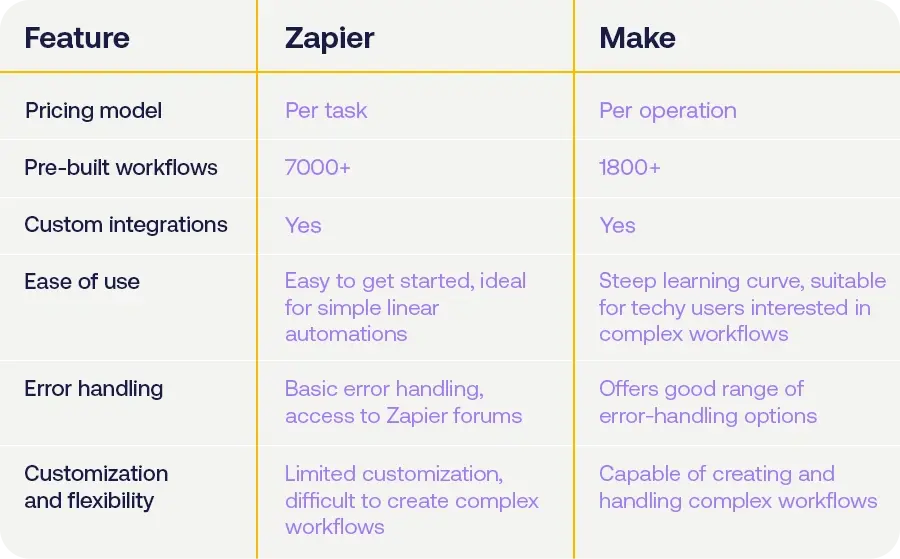
Table 1: Comparing the features of Zapier vs Make (as of January 2025)
Now that we’ve provided a broad comparison of Make vs Zapier, let’s dive deeper into the unique features that distinguish these two platforms.
1. Pricing
Key takeaway: While comparing Zapier vs Make, Make proves to be more cost-effective for complex workflows, while Zapier's prices are initially low but can quickly increase as the scope of your automations increases or becomes more complex.
Both Zapier and Make offer tiered pricing models based primarily on the volume of tasks or actions. Zapier charges by task, where a task is a single data item that has been successfully processed in a single action step. For example, if a Zap receives 10 emails at once, uploads an attachment to Dropbox (one action) and sends a Slack message for each (another action), we are already at 20 tasks. However, certain elements such as triggers, filters, paths and various internal actions such as formatter, delay and looping do not count as tasks.
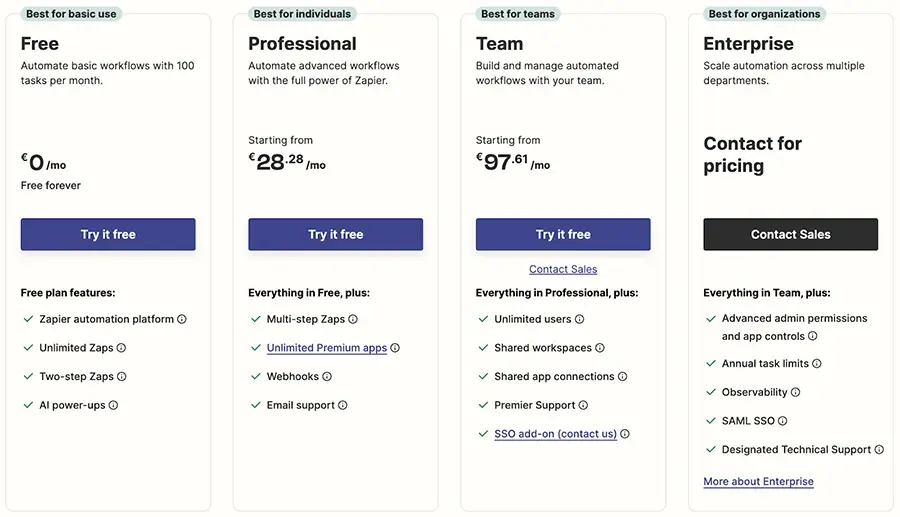
Zapier pricing as of January 2025
To get a feel for the tool, you can create up to 5 Zaps (automated workflows) with the free version of Zapier, with a limit of 100 tasks per month. These tasks are two-stage, i.e. each Zap can have a trigger and an action, e.g. when X happens (trigger), do Y (action).
In contrast, Make calculates according to processes. Every time a module executes an action in a scenario, this counts as an operation. The first module always counts as an operation, even if it returns no other result (a data element); in other words, it also counts as an operation if the module "searches" for new data, even if it finds none. You can also test Make for free, but you can use a maximum of 2 active scenarios and up to 1,000 operations per month.
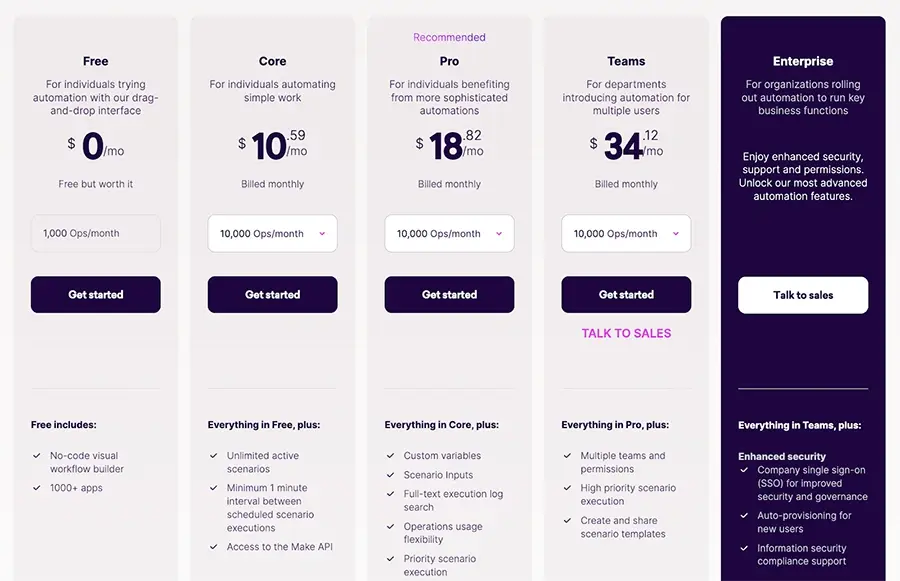
Price of Make.com as of January 2025
Only the basic functions are included in the free versions, whereby you pay additionally for actions and processes in all plans if you exceed the monthly quotas.
2. Usability
Key takeaway: Getting started with Zapier is easier, but Make is convincing because more technically experienced users have more autonomy and options for creating complex workflows.
Both Zapier and Make are no-code or low-code automation platforms designed to simplify the automation of workflows. Zapier, with its simple and intuitive interface, allows users to create linear automations step-by-step. It provides step-by-step guidance on the data required for each field and most actions do not require programming knowledge. Zapier does offer branching options, but these are not always intuitive and make it difficult to understand the structure of an automation at a glance. This complexity is compounded when colleagues unfamiliar with the workflow setup try to understand or customize it. The clarity of Zapier's error messages could also be improved. At the moment, users simply have to test their way through or resort to help in forums.
On the other hand, Make offers a flowchart-like interface that is ideal for creating sophisticated automations with branching paths. A similar form layout to Zapier is used for module configuration, but a more technical language is used, making it less plug-and-play. This does require some familiarity with basic programming concepts such as "string" and "variable", but does not require advanced programming skills. Make also includes table-like functions for working with numbers, text and data, making it accessible to no-code hobbyists.
One of Make's unique features is its advanced data manipulation capabilities. Users can utilize Make's features such as conditional branching, loops and error handling to create complex and sophisticated automation workflows. This allows them to handle large amounts of data and automate data collection, cleansing, integration and analysis. These features are particularly useful for users who need to work with large amounts of data. However, it is important to note that Make has a maximum file size, so users should check the pricing tier/package for their specific needs.
Ultimately, the decision between Zapier and Make depends on the user's experience and preferences. Both platforms are reliable and based on AWS, but beginners may prefer the simplicity of Zapier, while advanced developers may opt for the customizability and sophistication of Make.
3. Integrations & Ready-Made Templates
Key takeaway: Zapier and Make offer a wide range of integrations with the ability to request additional apps (via API), as well as access to a library of pre-built templates to help you get started quickly. These templates cover common automation scenarios and can be customized to meet specific needs.
Designed with simplicity and scale in mind, Zapier offers over 7,000 integrations and a straightforward process for creating automations. Zapier covers a wide range of applications, allowing users to connect many tools without the need for in-depth technical knowledge.
However, Zapier categorizes its most popular integrations as premium apps that are only available on higher-tier plans. Many of these useful apps, such as Shopify, Facebook, Salesforce and Webhooks, are considered "premium". This results in higher costs for companies that rely heavily on these premium integrations.
Make is great for complex workflows with multiple steps and conditional logic. It supports complicated operations such as iterators, routers and data transformers. Make allows for deep customization and fine-tuning, including custom API integrations and advanced data manipulation. It supports a wide range of apps, including high-end apps with advanced use cases that are only accessible via the most expensive Enterprise plan.
Unlike Zapier, Make doesn't make much of a distinction between standard and custom apps. However, it is important to note that some enterprise apps are only available on the highest enterprise plan. Access to most other apps is based on the operating limits of your plan, providing predictable costs for users who need advanced integrations. This structure makes Make a flexible and cost-effective solution for users who need advanced integrations, but also for those who need access to specific enterprise apps.
4. Error handling
Key takeaway: While error handling in automation is still a work in progress, Make offers better options for error handling, as users often find Zapier's error handling to be vague and inadequate.
Both platforms have error handling mechanisms, but they differ significantly in how errors are managed and reported. Zapier offers basic features such as error notifications and simple retry logic. These features are useful for solving minor problems that may occur during the execution of workflows. However, for complex workflows that require robust error management, Zapier's features are inadequate, often requiring users to seek help in forums.
In contrast, Make offers more comprehensive error handling options. These include the ability to set up custom error paths, implement retry logic and options such as ignore, resume and rollback. These features help users to track and rectify errors independently. This type of error handling is particularly useful for complex workflows, but requires a certain level of technical understanding.
Both platforms are testing AI assistance for error handling: Zapier uses a custom ChatGPT on OpenAI, while Make has an embedded AI chatbot. However, this AI assistance is still very basic and needs further development to better manage errors and documentation for each step, filter and module to match human expertise. Nonetheless, this is an area that is rapidly evolving and improvements are expected soon, promising more efficient and effective error handling in workflow automation.
5. AI Capabilities
Key takeaway: both Zapier and Make have integrated AI chatbots to improve workflow creation and management, with Zapier going one step further and utilizing OpenAI's ChatGPT for additional functionality.
Both Zapier and Make have integrated AI chatbots into their platforms. Users can enter their requests and the system searches its library to find suitable workflows or help create one.
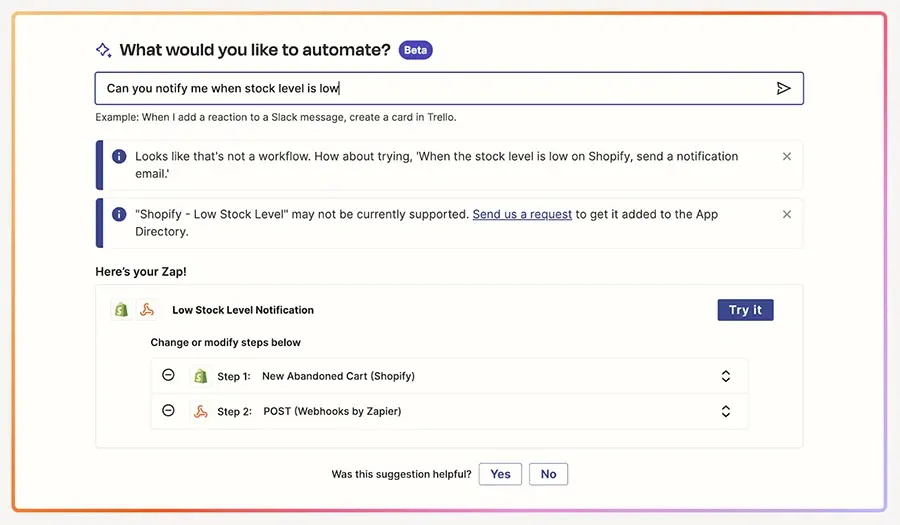
Asking Zapier's AI chat to find a “Zap”
Zapier has gone one step further and integrated a plugin for ChatGPT from OpenAI. This plugin, which is currently in beta, allows users to perform automated actions in Zapier by simply sending a request to ChatGPT. Despite some teething problems, this feature has the potential to revolutionize automation significantly and give Zapier a slight edge in AI capabilities.
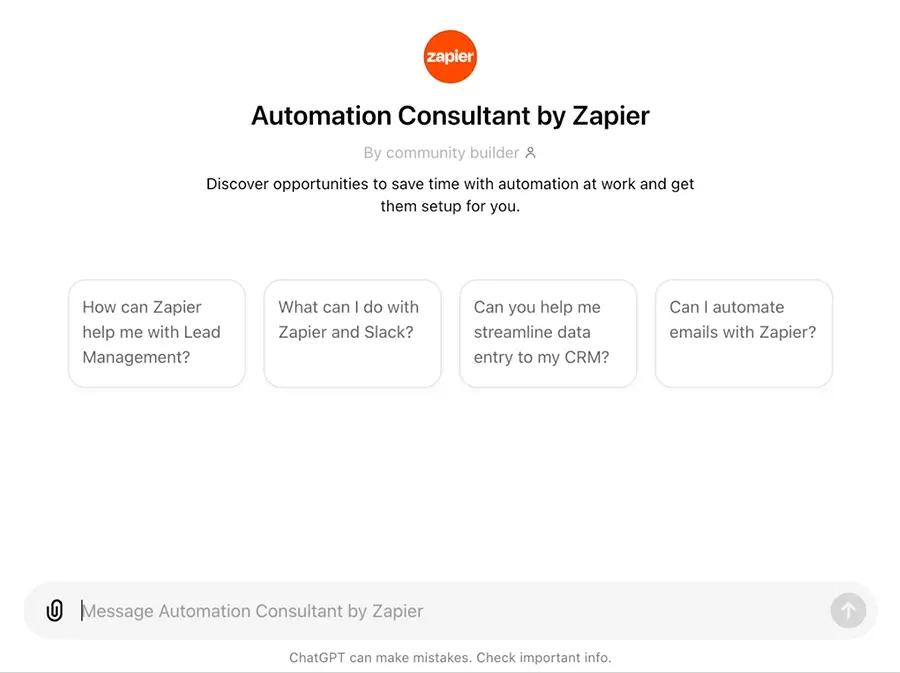
The Zapier plugin for ChatGPT from OpenAI
On the other hand, Make's AI assistant suggests creating new scenarios if a predefined template does not meet the user's requirements.
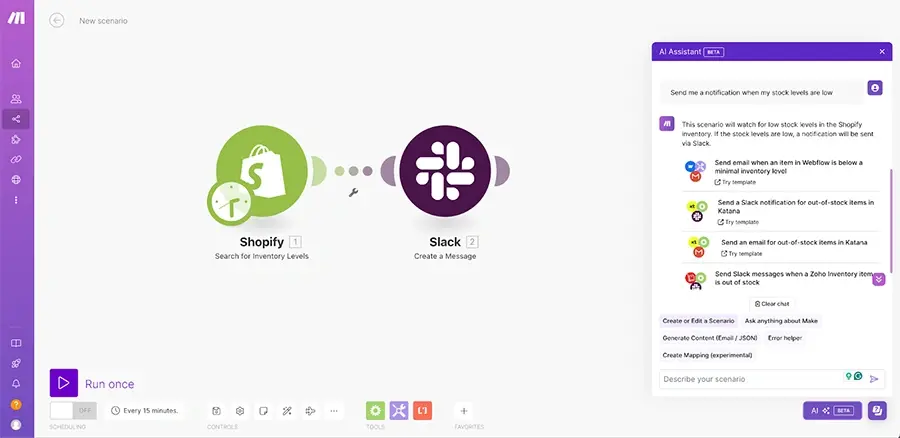
Asking the AI chatbot to create a workflow, a “scenario,” on Make
Both platforms allow for error handling, but troubleshooting can still be improved, especially when it comes to subtleties and nuances. This is an area where both platforms could improve their AI capabilities to provide a more seamless user experience.
🚀 To summarize, both Zapier and Make offer robust automation features. Zapier's simplicity and extensive app integrations make it the ideal choice for beginners, while Make's advanced customization options and error handling cover more complex needs. The choice between the two largely depends on your specific requirements, goals and budget.
Alternative to Zapier and Make: Shopstory
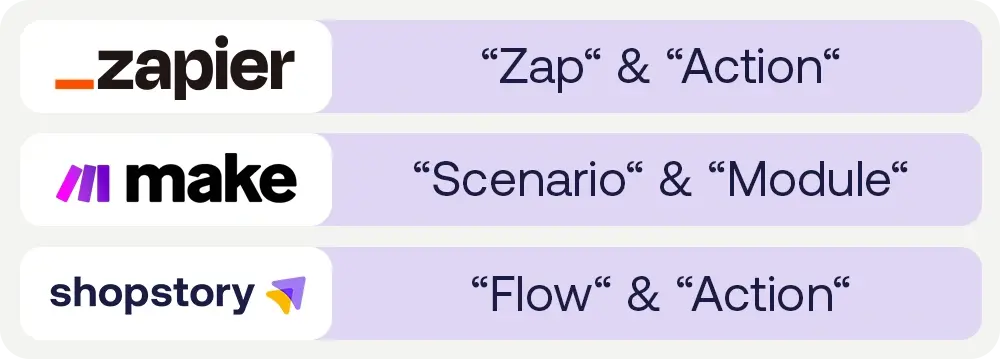
Zapier vs Make vs Shopstory: Automation platforms and their key terminology for workflows and actions.
Make and Zapier are both well-known automation platforms, but there is also an alternative that is worth considering: Shopstory. This is a workflow automation software designed specifically for ecommerce and performance marketing.
Shopstory connects your online store and your marketing tools and allows you to automate your workflows without needing a single line of code. While Zapier offers a wide range of integrations, Shopstory has a wide range of possibilities with all its ecommerce and marketing integrations.
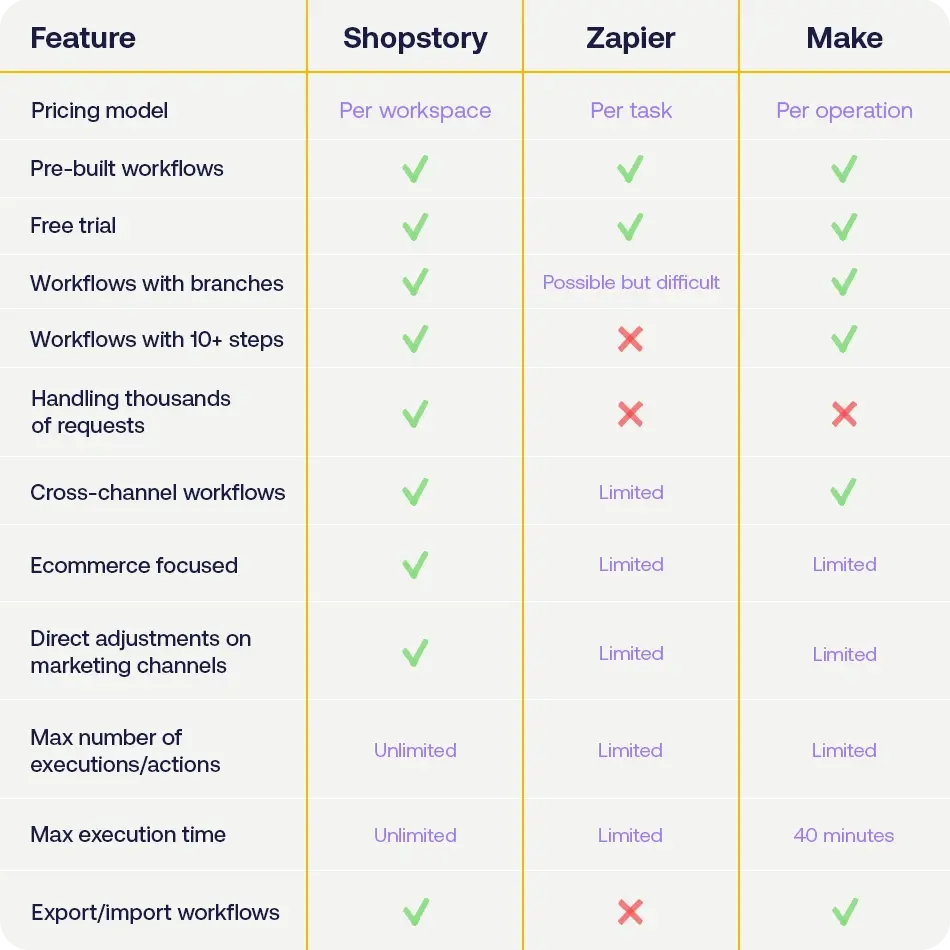
Zapier vs Make vs Shopstory: Comparing key features of all platforms.
Pricing & Scalability
Key takeaway: While Zapier and Make start with cheaper rates, Shopstory's pricing proves to be the most cost-effective when online stores or marketing agencies scale.
Let's not kid ourselves. Price is a decisive factor in the selection of tools. And when it comes to automation tools, every trigger and action counts, as well as their limit.
Zapier's pricing plans limit the number of tasks you can run per month. A "task" in Zapier is a trigger or action. For example, if you set up a Zap to send you an email notification (an action) when you receive a lead (a trigger), that counts as two tasks. If you exceed your task quota in a month, you can pay for additional tasks. If you're looking for simple and occasional automation, Zapier could be your first choice.
Make works similarly to Zapier, with plans limited to a certain number of 'tasks' per month, which is equivalent to a 'task' in Zapier. However, Make counts a task when the workflow searches for new data, even if it doesn't find any. Also, Make limits data transfer (5 GB per 10,000 operations per month), while Zapier and Shopstory do not measure this. If you're looking for affordable low-code automation aimed at technical users, Make could be a good choice.
On the other hand, Shopstory offers an intuitive user interface, advanced workflow features and scalability. Basically, it combines the best automation platforms into one and is suitable for all users, whether they are new or tech-savvy. But perhaps we can best illustrate the scalability aspect with an example.
Let's look at three scenarios of online stores: one with 1,000 products, another with 2,500 products and a third with 5,000 products. As a use case, we will run a daily report called Labelizer. This workflow goes through all your products and labels them according to their campaign performance, for example on Google ads. (A workflow in Shopstory, called "Flow", corresponds to a Zap in Zapier and a Scenario in Make).
In Shopstory, the Labelizer Flow has nine actions within the workflow, and this information is crucial for automation software that has a limit on the number of executions or tasks, as we'll see in a moment in the comparison. Shopstory's plan offers an unlimited number of executions and an unlimited execution time. If online stores or agencies increase the number of products, this will have a strong impact on competitors' prices, as you will see. We will go into this in more detail below.

Zapier vs Make vs Shopstory and the monthly costs in relation to the number of products and actions managed.
As the table shows, the costs for automation tools such as Zapier and Make increase significantly as the number of products increases, as more execution steps are required. In this example, only a single activated workflow in an online store is considered. In reality, ecommerce stores have dozens of workflows, so the cost of alternative platforms skyrockets as automation increases.
Shopstory stands out for its scalability for ecommerce and marketing automation, offering a fixed price that simplifies cost management and allows for stress-free growth. As your ecommerce business expands, Shopstory can grow seamlessly with it. In contrast, Make's free plan limits execution time to five minutes and the paid plan to 40 minutes. For a store system with tens of thousands of products, longer execution times may be required, leading to potential time-outs with limited automation tools.
To summarize, Shopstory is a cost-effective solution tailored to ecommerce and marketing, without the unnecessary features of general automation platforms. While Shopstory may be more expensive for users with basic automation needs, its scalability and ecommerce-specific features make it a robust and efficient choice for growing businesses.
A Ecommerce & Performance Marketing Focus
Key takeaway: Shopstory connects ecommerce tools like Shopify, WooCommerce, Shopware 5 and Shopware 6 and seamlessly integrates them with top marketing tools like Google Ads and Meta Ads. Unlike platforms like Zapier, Shopstory focuses on deep, robust connections that are specifically tailored to the needs of ecommerce.
For ecommerce companies that want to automate their store systems, Shopstory offers a comprehensive solution that supports the most important tools for commerce and marketing. This makes Shopstory the ideal choice for online stores using Shopify, WooCommerce, Shopware 5 or Shopware 6. Shopstory's native integrations minimize errors and expand the possibilities to ensure reliable and efficient automation.
Some of Shopstory's ready-to-use workflows include:
- Burnt budget tracker (Google Search campaigns): Monitor the budget you've spent on keywords or products in your search campaign and find out which keywords are converting and which aren't. This helps you close gaps and seize low-hanging opportunities.
- Top 100 products ranking & availability report: Generate reports with the articles that performed best in the last year, based on the value of conversions. The report also highlights recent clicks to show the availability of the items.
- Increase the budget for performing meta campaigns: Automatically increase the daily budget for powerful meta campaigns based on predefined conditions and enable dynamic resource allocation for successful campaigns.
- Set keyword to Exact Match when CTR is high: Optimize your Google ads by adding keywords with a click-through rate (CTR) of over 2% as an exact match, increasing the accuracy and effectiveness of your ads.
In addition, Shopstory enables cross-channel automations, such as the creation of comprehensive weekly reports that summarize all advertising channels in a single table, further streamlining your marketing efforts.
As an ecommerce automation software, Shopstory is equipped with native, deep integrations between store systems and marketing/advertising tools. This versatility also makes Shopstory's software appealing to marketing agencies looking to work with ecommerce clients and scale.
Ease of Use & AI Assistant
Key takeaway: Shopstory's platform offers a Flow Library with ready-to-use workflow templates, a Flow Guide for each template to help you start a workflow in minutes, and an AI Assistant available 24/7 to answer your questions or help you create flows.
Shopstory's no-code platform is designed to provide all users with automation options right from the start. Therefore, the Flow Library offers a wide range of ready-to-use workflows, each tailored to common ecommerce tasks. Whether it's managing inventory, optimizing campaigns or automating reports, there's a pre-built automation template that you can launch within minutes. And if you have a unique automation idea, you can create or request it directly on the platform.
But the ease of use doesn't stop there - each ready-made template comes with a Flow Guide, a step-by-step wizard that helps you set up your workflow in just a few minutes. It's like having an expert at your side to guide you through every step of the process. So you can quickly start effective workflows and save time and effort.
And finally, there's Shopstory's AI Assistant. This built-in feature is available 24/7 to answer all your questions and concerns about creating workflow automations at Shopstory. Whether you're new to automation or a seasoned expert, the AI Assistant will support you and make the process of creating and managing workflows as quick and smooth as possible.
Error Handling & Customer Success Support
Key takeaway: Shopstory offers dedicated customer success support and robust troubleshooting features that ensure users can quickly resolve issues and optimize their workflows.
Shopstory's error handling is transparent and helpful. Automated notifications show exactly where errors occur and provide detailed messages to help users understand and resolve issues. Shopstory's inspector tool helps users understand what happened during the execution of a flow and is therefore particularly useful for troubleshooting and gaining deeper insights into workflows. With the AI Assistant, users can also independently decode error messages and receive suggestions for troubleshooting.
In terms of support, Shopstory goes beyond just solving problems. The Professional and Enterprise packages include special Customer Success Support with regular, personalized assistance. This commitment underscores Shopstory's dedication to its users and makes automation smoother and more efficient.
Free Trial
The key takeaway: Unlike Zapier and Make, Shopstory's free trial offers full access to all premium integrations, functionality and features, allowing users to truly experience the value of the ecommerce and marketing automation software.
Shopstory's free trial offers full access to all premium integrations, functions and features, allowing users to explore and experience the power of Shopstory's automation tools without limitations. This unrestricted access is particularly beneficial for ecommerce and marketing users, allowing them to truly understand the value and potential of Shopstory's automation features.
Whether it's automating Bidding Strategies, adjusting budgets, optimizing feeds or creating multichannel reports, users can test these workflows with their online stores and real-world scenarios.
The free trial version of Shopstory does not require a credit card and is therefore a risk-free way to test the platform. The goal is to provide users with a comprehensive understanding of how Shopstory can improve their ecommerce and marketing operations, save time and serve as a catalyst for scaling. Start automating with Shopstory for free today.
Choosing the right tool for your team and business
Choosing the right automation tool for your business depends on your specific needs and technical knowledge.
The comparison of Zapier vs Make (vs Shopstory) did underline the fact, that established providers like Zapier have the advantage of being first to market and are ideal for those looking for an easy-to-use tool with a variety of integrations for simple, linear workflows. Make offers a solution for users who need complex automation workflows with an easy-to-use interface or who appreciate low-code features. Shopstory, on the other hand, is a relatively new player in the automation market and offers unparalleled value with its deep ecommerce and marketing integrations and personalized customer support. It is a worthwhile investment for ecommerce companies and marketing agencies looking for robust automation solutions. Shopstory supports store system integrations and advertising channels that streamline ecommerce operations, making it a compelling alternative.
By understanding the strengths and limitations of each tool, you can choose the one that best fits your automation needs and business goals. This way, you can increase efficiency, reduce manual tasks and focus on growing your business.
If you want to test Shopstory's no-code automation software and see for yourself, just follow the link:
More to Explore
Discover more insights from our latest articles
© 2025, Shopstory









